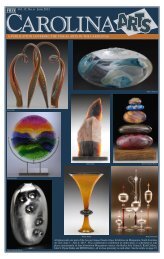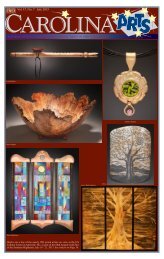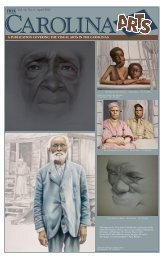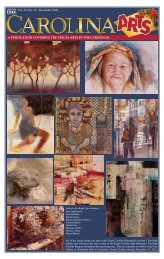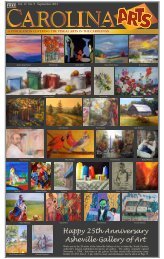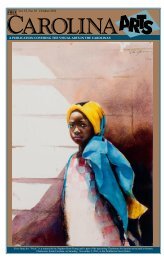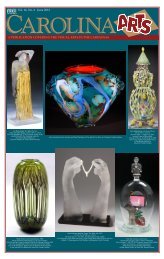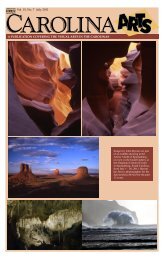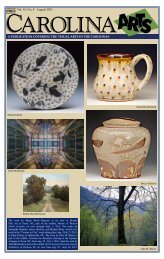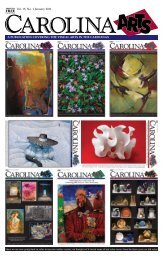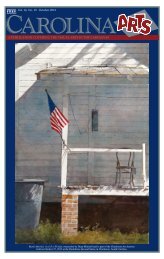Vol. 15, No. 3 March 2011 - Carolina Arts
Vol. 15, No. 3 March 2011 - Carolina Arts
Vol. 15, No. 3 March 2011 - Carolina Arts
- No tags were found...
Create successful ePaper yourself
Turn your PDF publications into a flip-book with our unique Google optimized e-Paper software.
Caldwell <strong>Arts</strong> Council in Lenoir, NCcontinued from Page 14from the bereaved, and photograph themodest effects, mementoes, and heirloomsheld onto after the death of a loved one.Each item, ranging from a below-the-kneeprosthetic leg to an old Atlantic City slotmachine, was photographed on a seamlesswhite background, focusing on the wearapparent on each surface. It was importantfor each object to have a unique presence,thus the scale of each photo was based onthe personality of that item.Because the photos often raised questions,Servon sought collaboration withpoet Lorene Delany-Ullman. Prose poemswritten by Delany-Ullman provide insightinto the objects, the lives and deaths ofthe deceased loved ones, and the placesof those objects in the memories and livesof the people who saved them. Throughinterviews, the new object-owners wereasked to describe their relationship withthe deceased, any distinguishing characteristicsor traits of that person, a memorableoccasion or event shared betweenthem, and what makes that object special.Based on the interviewees’ responses,Delany-Ullman crafted prose poems,which chronicle the relationships betweenthe new and original object owners, theirlives and deaths. While the items may befunctional, and are sometimes utilizedin daily life, their value is based in theirmemorial function: their ability to keepthe dead alive in the minds of their newowners.Michael Twery offered the followingstatement about his works, “My concernsas a painter cover a variety of interests andprocesses. As a result, I work on four differentbodies of work that each allow meto express myself in very different ways. Ifind that alternating my method of workinghelps strengthen my abilities in eachdifferent area. I have always been fascinatedby the shape and quality of light andhow it creates environment and mood.I also work with implied meanings ofshape and color, context of subject matter, surface quality and sheer painterliness ina painting. I often incorporate glow in thedark paint to add another viewing dimensionto my work.Work by Michael Twerytion and ability to create illusion, moodresponse and context.”“Formal concerns aside, my subjectsand content range as far as an old ironlock, to the visual expression of theGolden Ratio,” add Smith. “The work isrendered with limited depth, realistic andrendered in a limited palette. All of theseaspects are influenced by Trompe L’oielAmerican painters of the early twentiethcentury. I am particularly moved by theThe <strong>No</strong>rth <strong>Carolina</strong> Arboretum inAsheville, NC, is presenting, Emissariesof Peace: The Cherokee and British Delegationsof 1762, a historical exhibit ofa British officer’s journey to a Cherokeevillage, on view through May <strong>15</strong>, <strong>2011</strong>.After battles, towns set ablaze, ambushesand bloody massacres, the Cherokeeand British were on the brink of treatyin <strong>No</strong>vember 1761, but one conditionremained. The Cherokee warriors gatheredat Fort Robinson asked that a Britishemissary return with them to their villageas a gesture of goodwill. This exhibitchronicles the story of that visit, taken byofficer and journalist, Henry Timberlake.Emissaries of Peace, brings HenryTimberlake’s memoirs to life throughartifacts, archaeological treasures, periodartwork, music, video, and life size figures.Timberlake, a junior officer, volunteeredto accompany the Cherokee back tothe Overhill towns after the British officerin charge deemed the mission too perilousto assign. The young Timberlake, alongwith another officer, an interpreter and aservant, set out on the journey by canoeon <strong>No</strong>vember 28, 1761.Visitors to the exhibit will experiencetwo contrasting cultures emerging fromwar and navigating the path toward peace.From the council houses of the Cherokeesto the pleasure houses of London, Emissariesof Peace provides a look at Cherokeeand English society of the mid-18thcentury, each viewed through the eyes ofthe other.“The ‘Mikigami’ series reflects myfascination with taking everyday mundaneobjects out of their normal contextand seeing them in a different way; withtheir shape playing an important role inhow they are viewed,” adds Twery. “Thepaintings are careful observations andrepresentations of real objects, yet often atfirst glance look very abstract. The shapesmade from folded candy wrappers suggestother objects and forms which vary dependingon different viewers own imaginations.The ‘Mikigami’ paintings are allacrylics on cut out signboard. The edgesof each piece are painted with phosphorescentpaint so the cut out shapes glow inthe dark. I work with cut-outs because Ithink the irregular shapes strengthen identificationof the painting as an object.”Gregory L. Smith offered the followingstatement about his works, “My primaryinspiration are the physical proprietiesof paint. Paint is fluid, plastic and hasdimensionality. All of these aspects canbe explored and exploited. Paint mayrendered in all levels of opacity, valueand tone. As a medium paint is unique.Its properties are infinite in their applica-continued above on next column to the rightwork John Peto and John Haberle.”“The combination of these formal andstylistic concerns continues to inspire andpush me to explore. <strong>No</strong>thing is off limits,nothing out of bounds. I hope to continueto work around these concerns for manyyears to come”.For further information check our NCInstitutional Gallery listings, call the <strong>Arts</strong>Council at 704/754-2486 or visit (www.caldwellarts.com).<strong>No</strong>rth <strong>Carolina</strong> Arboretum in Asheville,NC, Features Historical ExhibitionThe exhibit was originally producedby the Museum of the Cherokee Indianfor the Smithsonian Institution NationalMuseum of the American Indian. It is theonly traveling exhibition produced bymembers of an American Indian tribe. Theexhibition received the presidential “Wethe People” exhibit designation becauseof its excellence in telling the story ofAmerican history.To broaden the visitor experience,an exhibit called Corn, Beans & Squashexplores the agriculture practices of theCherokee and neighboring tribes of theCreek Confederacy. The exhibit, designedand produced by the Arboretum, featuresa seasonally appropriate garden of thelate 1700s and displays native plants usedfor food. Examples of a Cherokee summerhome and corn grinder, as well asa diorama of a village provide visitors aglimpse of life for the Cherokee.The exhibit is sponsored by the NationalEndowment for the Humanities, theCherokee Preservation Foundation, FirstCitizens Bank, Harrah’s Foundation, theCannon Foundation, the Colonial WilliamsburgFoundation, and the Museum ofthe Cherokee Indian. Exhibition support atthe Arboretum is provided in part by The<strong>No</strong>rth <strong>Carolina</strong> Arboretum’s CommunityPartner, Smoky Mountain Living.For further information check our NCInstitutional Gallery listings, call the Arboretumat 828/665-2492 or visit (www.ncarboretum.org).<strong>Carolina</strong> <strong>Arts</strong>, <strong>March</strong> <strong>2011</strong> - Page <strong>15</strong>



